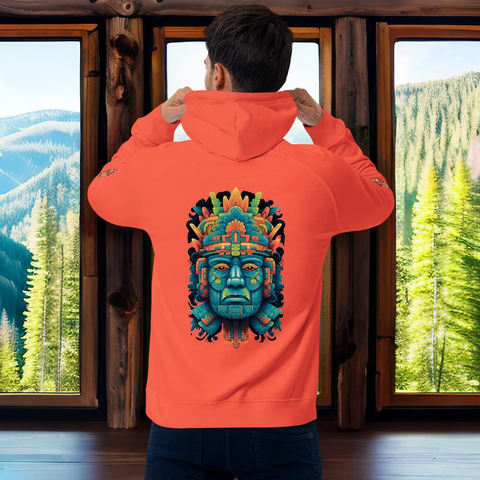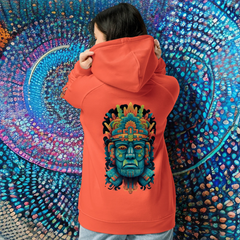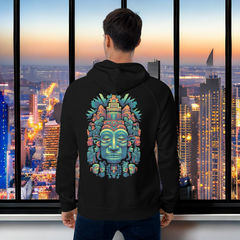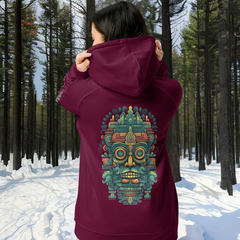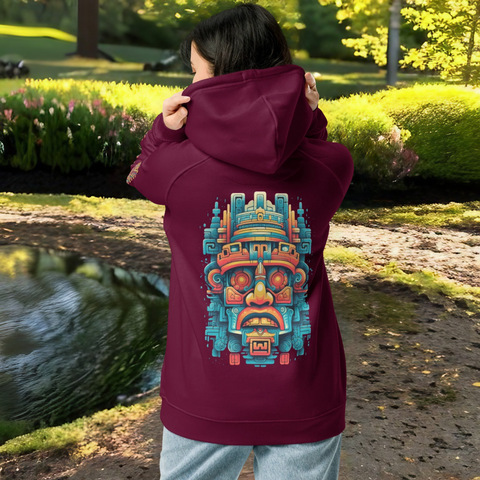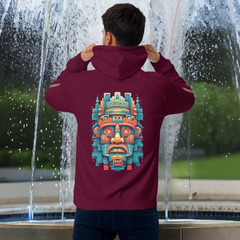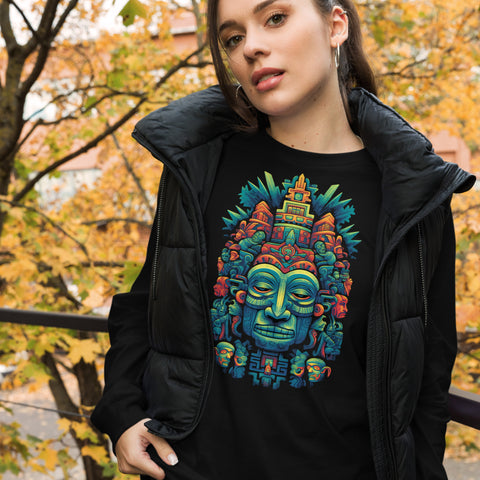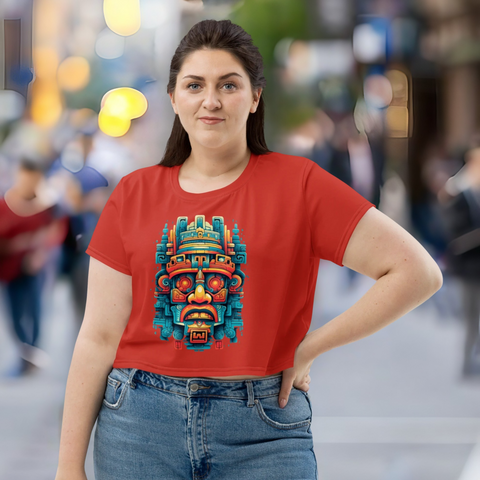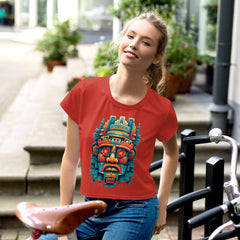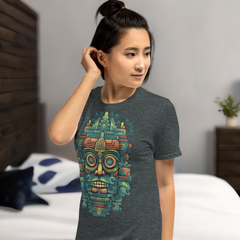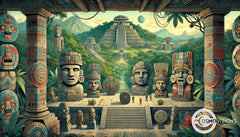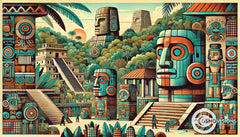Unlocking the Secrets of the Ancient Olmec Civilization: A Journey into Mesoamerica's First Great Culture
Posted by Massimiliano Geraci

The Olmecs lived thousands of years ago and started what many call the first great Mesoamerican civilization. They set up their homes in what we now know as Mexico, near the Gulf Coast.
Their rich and complex society paved the way for other cultures like the Maya and Aztecs. The ancient Olmec culture is often seen as the 'parent' civilization of much of Mesoamerica. The Olmecs carved huge stone heads from volcanic rock, created detailed jade figurines, and were among the first to play a ballgame that’s still loved today.
These early people made big advances in writing, math, sports, and even had rituals that seem scary to us now. They figured out how to use rubber long before anyone else did. Their artists made some of the most beautiful artwork from ancient America.
We owe much of our knowledge about stars, seasons, and timekeeping systems to them because they invented calendars that were accurate for farming or religious events. The Olmecs show us how old human ingenuity is and remind us of our connections to people who lived long before there were computers or cars.
Understanding the Foundation of Mesoamerican Civilization
Mesoamerican civilization began with the Olmecs, setting a foundation that later cultures would build upon. They thrived due to the fertile lands and rivers in what is now Mexico. These natural resources allowed them to create a society where trade, politics, and religion played key roles.
The Olmec period was significant for its long-distance trade networks, including the trade of materials like obsidian, and the expansion of interregional trade routes. This period also saw the presence of Olmec artifacts across Mesoamerica, highlighting their extensive influence.
Their cities like La Venta and San Lorenzo became hubs of activity that drew people from near and far.
Their way of life influenced others around them, creating a ripple effect across Mesoamerica. The Olmecs developed systems that included writing, which was a big step for human communication at the time.
Though they vanished around 400 BCE due to environmental changes, their impact lasted much longer. Artifacts like colossal stone heads remind us of their skill and creativity.
The Olmec Society: An Insight into the Life of Mesoamerica's First Major Civilization
Building on our understanding of Mesoamerican civilization’s roots, we delve into the lives and society of its earliest pioneers, the Olmec people. They settled across modern-day southern Mexico, making homes in areas now known as Veracruz and Tabasco.
This society thrived from around 1150 to 900 B.C.E., marking a period where San Lorenzo emerged as a pivotal community. The Olmec crafted permanent city-temple complexes, showcasing their devotion and organizational skills.
Various factors, including environmental changes, tectonic upheavals, and volcanic eruptions influenced the growth and decline of the Olmec population. Thriving farming villages and cities, along with the cultivation of crops and natural resources, contributed to their prosperity.
These sites became centers for religious activities and societal gatherings.
The Olmecs are celebrated for their monumental sculptures, notably the colossal heads carved from basalt—a hard volcanic rock they transported over long distances despite lacking modern tools or animals to aid them.
These heads have intrigued archaeologists and art lovers alike. They embody the skill and spiritual depth of Olmec artisans. Each stone face tells a story, possibly representing revered leaders or deities within Olmec culture.
Beyond sculpture, this civilization's legacy includes intricately designed jade figurines and remnants of what might be one of the earliest writing systems in Mesoamerica. These artifacts offer glimpses into daily life, religious beliefs, and social hierarchies that defined this foundational society.
How the Olmecs Influenced the Maya, Aztec, and Beyond
The Olmecs shared their knowledge and beliefs with the Maya, Aztec, and other groups in Mesoamerica. They created pathways for trade that allowed them to exchange goods like jade figurines, pottery, Olmec artifacts, and even ideas.
These trades helped spread Olmec culture far and wide. Their art and religious symbols made their way into the traditions of later societies.
This ancient group also taught others about their calendar system and the concept of zero, which were big steps forward for math and timekeeping. Many gods from Olmec religion became important in cultures that came after them.
The snake-god idea grew into major gods for the Maya and Aztecs. These influences ensured that the Olmecs' legacy lived on long after they were gone.
Exploring the Mystery of the Olmec Colossal Heads
Giant stone sculptures reveal secrets of the ancient Olmec civilization. Art lovers marvel at these massive artworks, known as Olmec colossal heads. Crafted from single blocks of stone, each head tells a story.
These faces carved in rock show rulers who once led the Olmecs.
Artists and workers moved these heavy stones from far away places without modern tools. They likely rolled them on logs and floated them down rivers to their final spots. In cities like San Lorenzo and La Venta, they stood tall.
These heads make us wonder about the skills and beliefs of people long gone.

The Significance of the Colossal Heads in Olmec Culture
The colossal stone heads are mighty symbols of Olmec leaders' power and divine authority. Carved with remarkable skill, these large sculptures give us a peek into the advanced artistic talents of the Olmec people.
They shaped these figures from stone, showcasing faces that might be those of their rulers. This shows how highly they valued their leaders and possibly their spiritual beliefs.
The colossal heads are markers on our journey to understanding the depth of Olmec society.
These massive sculptures also help us see clues about where important ceremonies or rituals happened in Olmec lands. Found across present-day Mexico's Gulf Coast, including areas like Veracruz and Tabasco, they highlight key spots in what was once a bustling civilization.
Through studying them, we learn about Olmec art, their political systems, and how they governed themselves.
How Were the Olmec Colossal Heads Created and Transported?
The colossal heads of the Olmec culture symbolize their remarkable skill and spiritual beliefs. These heads reveal how advanced and connected the Olmec people were.
1. Artists chose large boulders from basalt quarries, often located far from the Olmec heartland.
2. Workers used stone tools to roughly shape the rock into a head at the quarry site.
3. They smoothed the surface with sand and water, adding detailed features last.
4. Transporting these giant heads required teamwork and ingenuity.
5. Teams of 1,500 people or more moved them over land.
6. They rolled the heads on logs pulled by ropes.
7. Water routes were sometimes used, floating the heads down rivers on rafts.
8. The journey took three to four months of hard work.
9. Upon arrival, these heads were set up in central spots within Olmec cities as symbols of power and religion.
10. Ceremonies might have been held to celebrate their completion and placement.
These steps highlight the Olmecs' deep connection to their environment, society's organization, and spiritual practices through art.
Deciphering the Stories Behind the Stone: Theories and Archaeological Insights
Moving from how these giant stone faces were made and moved, we now explore what they mean. Experts dig into the earth and study old writings to figure out the stories of these big heads.
They think each head was a portrait of an Olmec king. These kings ruled over lands in what is today southern Mexico. The story behind each carved rock could tell us how these leaders lived or fought.
Archaeologists use tools like brushes to gently remove dirt and scanners that see under the ground to find hidden Olmec sites. They also look at old objects found nearby, such as pottery shards or small sculptures, for more clues about the colossal heads.
This hard work helps explain why the Olmecs built them. Some say it was for worship, and others think it showed power. Each discovery brings us closer to unlocking the mysteries of this ancient culture that left behind striking art pieces without words.
The Rise and Fall of Olmec Civilization: What Happened?
The Olmec civilization thrived in the lush lands of what is now Veracruz and Tabasco, from about 1200 BCE to 400 BCE. They were Mesoamerica's early settlers, building impressive city-temple complexes and creating striking art, including the famous giant stone heads.
Their society was rich and complex, heavily influencing later groups like the Maya and Aztecs.
Around 400–350 BCE, the Olmecs' lives drastically changed. Climate shifts made farming difficult in their homeland near Mexico's Gulf Coast, and these environmental challenges forced them to abandon their cities and temples.
As they moved in search of new land, their once-great civilization started to fade away. Archaeologists have uncovered artifacts that give us clues about these dramatic changes—puzzle pieces showing how nature can reshape human history.
Tracing the Timeline: From the Olmec's Emergence to Their Decline
The Olmec civilization marked the beginning of complex society in Mesoamerica around 1200 B.C.E. It flourished until about 400–350 B.C.E., demonstrating notable achievements and influences.
1. Ancient Mexico witnessed the rise of the first major Mesoamerican civilization, the Olmecs, around 1200 B.C.E.
2. Fertile lands along the Gulf of Mexico supported their early growth, aiding in agriculture and settlement development.
3. San Lorenzo became one of their earliest large centers, thriving from 1150 to 900 B.C.E.
4. Following San Lorenzo's decline, La Venta emerged as a powerful center around 900 B.C.E., showcasing monumental architecture and intricate artifacts.
5. The Olmecs developed trade networks extending beyond their heartland into other regions of ancient Mexico and Central America.
6. Through these networks, they influenced surrounding cultures, trading goods like jade and obsidian while spreading artistic styles and religious beliefs.
7. Olmec artisans crafted colossal stone heads, symbolizing perhaps rulers or gods, which remain iconic symbols of their culture's artistic prowess.
8. The Olmecs were not just artists but also farmers who likely grew crops such as maize and beans, sustaining their communities and supporting population growth.
9. Decline began around 400–350 B.C.E., partially due to environmental changes that made farming difficult in their home region.
10. These challenges forced migrations and led to a gradual disappearance of centralized Olmec power, leaving behind ruins for archaeologists to uncover.
This timeline follows the arc from emergence to decline, highlighting key aspects such as societal achievements, economic practices, cultural impacts, and eventual challenges leading to their fading presence in ancient history texts.
Climate Change, Wars, and Migration: The Factors That Forced the Olmec to Move
Climate shifts hit the Olmec hard. These changes made their lands less fertile and harder to farm. Rivers that once fed their crops dried up or became unpredictable. As food grew scarce, tensions rose.
Neighboring groups started fighting over the remaining resources, and battles broke out, driving some Olmec communities to seek safer places.
Migration was not a simple choice but a need for survival. They looked for new areas where water was plentiful and soil could support their farms again. Moving allowed them to continue their way of life elsewhere, around states like Veracruz and Tabasco.
This journey reshaped their society and forever left a mark on Mesoamerica's history.
Archaeological Discoveries: What They Tell Us About the Olmec's Demise
Archaeologists found clues in the lands of Veracruz and Tabasco. These discoveries show that big environmental changes happened around 400 to 350 BCE. The Olmec, who were great farmers, could not stay because the land changed too much.
They had to move away from their cities like La Venta and San Lorenzo.
Environmental shifts pushed the Olmec out of their homeland.
Tools like carbon dating helped scientists figure out when these changes took place. By studying artifacts left behind, researchers learned how the Olmec lived and why they had to leave their homes.
Artifacts include things like pottery, tools, and even remains of their buildings at sites such as Tres Zapotes and Laguna de los Cerros.
Key Archaeological Sites of the Olmec Civilization: A Guide
The journey through the Olmec civilization leads us to their ancient sites. These places show us the grandeur of Mesoamerica's first major society.
1. San Lorenzo: Known as one of the earliest significant settlements, San Lorenzo thrived around 1200 BCE. The site showcases monumental sculptures and sophisticated drainage systems, reflecting early advancements in engineering.
2. La Venta: After San Lorenzo, La Venta became the Olmec heartland by 900 BCE. This spot is famous for its towering earthen pyramid and elaborate offerings buried within, hinting at deep spiritual practices.
3. Tres Zapotes: This location reveals continuity in Olmec culture even after other cities declined. Discoveries here include one of the last colossal heads and evidence of a calendar system, illustrating sustained intellectual growth.
4. Laguna de los Cerros: Less known but equally vital, this area provides insights into daily life and urban planning during the Olmec era with its residential zones and public buildings spaced around central plazas.
Each site gives a unique glimpse into how the civilization blossomed across fertile lands before eventually moving due to various pressures, such as climate change and resource depletion.
La Venta and San Lorenzo: Exploring the Heart of Olmec Civilization
Moving from the broad view of Olmec sites, we zoom into La Venta and San Lorenzo. These places show us the heart of Olmec life. Around 900 BCE, La Venta rose to prominence as San Lorenzo's influence faded.
This shift marks a key moment in Mesoamerican history. Here, powerful leaders built impressive structures that stood tall among lush green landscapes.
La Venta thrived as a central hub for the Olmecs. It became known for its complex culture and religious practices. Their builders crafted massive stone sculptures and ceremonial centers that tell stories of their beliefs and society.
Meanwhile, San Lorenzo tells an older tale. Before La Venta's rise, it was where early Olmecs made their mark on the world with grand creations symbolizing power and spirituality.
Tres Zapotes and Laguna de los Cerros: Uncovering Lesser-Known Olmec Sites
Tres Zapotes and Laguna de los Cerros are hidden gems in studying ancient civilizations. These sites sit quietly in Mexico, holding secrets of the Olmec world. They show us how advanced the Olmecs were.
Their giant buildings and detailed ceramics impress everyone who sees them.
Monuments do not lie; they stand tall as evidence of a culture's reach and creativity.
Artifacts found here have changed what we know about ancient Mesoamerica. They reveal stories of power, religion, and connections outside their borders. Explorers see earthen mounds that touch the sky and pyramids that point to the Olmecs' knowledge of stars.
This makes Tres Zapotes and Laguna de los Cerros key places to understand a civilization lost in time but foundational to everything that came after it in Mesoamerica.
Olmec Art and Symbolism: Decoding an Ancient Language
Olmec art tells a story older than words. Their statues, carvings, and masks paint pictures of their beliefs and daily life. The colossal heads stand tall as the most famous symbols.
Artists carved these giant stones into leaders' likenesses, showing power and respect. Each head is unique, capturing personal details hinting at stories from long ago.
Jade face coverings show another layer of Olmec genius. Combining human features with those of jaguars created images both beautiful and powerful. These works weren't just for looks; they marked high status among Olmec people.
Through such artifacts, we glimpse an ancient world full of ritual and reverence.
Next up, let's explore how these artistic expressions influenced the foundation of Mesoamerican civilization.
The Artistic Legacy of the Olmecs: From Colossal Heads to Intricate Jade Figurines
The Olmecs left behind a rich artistic heritage that still fascinates people today. They carved colossal heads out of volcanic basalt, creating works that weigh up to 55 tons and stand as tall as 3.4 meters.
These massive sculptures were not just art; they showed the faces of rulers and important figures in Olmec society, capturing their power and presence.
In addition to these towering stone heads, the Olmecs also crafted delicate jade figurines. These smaller pieces often blended human and jaguar features, showing the high skill of Olmec artists.
This unique "Olmec-style" became a mark of rank among the elites. Each piece, whether a giant head or a tiny figurine, tells us about the people who made them and the world they lived in.
Religious and Mythological Themes in Olmec Art
Moving from the striking colossal heads and jade figurines, Olmec art delves deep into a world where religion and mythology intertwine. Jaguars stand at the center of this spiritual landscape, not just as powerful animals but as divine beings.
One significant deity in Olmec religion is the Olmec Dragon, representing the earth with distinct features like flame eyebrows, a bulbous nose, and a bifurcated tongue. This deity was believed to provide rulers with a mandate to lead and was likely involved in religious activities and offerings at specific sites.
Artists carved jaguars into stone, weaving them into the fabric of their religious life. These majestic creatures symbolized strength and were often depicted with human features, creating a blend known as werejaguars.
The Kunz axes are prime examples, named after George Frederick Kunz who first described these ritual objects.
In this artistic realm, gods took many forms—from snakes to jaguars—linking Olmec beliefs to later civilizations like the Maya and Aztecs. Each deity carried distinct powers or attributes seen in carvings across temples and artifacts found throughout Veracruz and Tabasco.
This connection between past and future highlights how Olmecs laid down cultural threads that others would follow for centuries to come. Art wasn’t just for beauty; it expressed fantastic stories of creation, power, and transformation that continue to intrigue those exploring Mesoamerica’s first great culture today.

Understanding Olmec Iconography: Jaguars, Shamans, and Rulers
From the spiritual themes painted and carved by the Olmec, we move to decode their fascinating symbols. Through its art, the Olmec civilization shone a light on jaguars, shamans, and rulers.
Jaguars came alive in stone carvings; they were not just animals but symbols of might and spirituality. Shamans, seen as bridges between worlds, were often depicted merging human features with those of jaguars—showing their power to transform.
Rulers used jade face masks that blended human and animal traits. This mix showed their high status and divine connection. The art also pointed to a society where leaders had strong control.
They used these images to show they were chosen by the gods. By looking closely at these artifacts—carved stones, masks, sculptures—we start understanding how the Olmec viewed themselves in harmony with nature and the cosmos.
The Interconnected World of the Olmec: Trade, Influence, and Cultural Exchange
The Olmec civilization lit the paths between distant communities with its trade routes, weaving a network across Mesoamerica. It traded finely crafted artifacts that spoke of its skills and beliefs.
These objects, including jewelry made from jade and small statues carved in stone, traveled far from the states of Veracruz and Tabasco. Each piece carried some of the Olmec soul to places beyond their reach.
Their influence did not stop at goods traded; it shaped cultures that came after them. The Maya, Zapotec, Totonac, and even the mighty Teotihuacán civilizations felt the touch of Olmec ideas.
Through these exchanges, concepts like the Long Count calendar spread wide, showing how time itself was shared among those who would never meet. This unity birthed an era where innovation thrived on shared knowledge and mutual respect among diverse peoples.
Trade Routes and Economic Power: How the Olmecs Shaped Mesoamerica
Olmec traders set up networks that reached far across Mesoamerica. They traded jade from the Motagua River valley and obsidian from the highlands of Guatemala and Puebla, making them powerful and wealthy and shaping trade in ancient times.
Their goods traveled to distant lands, showing their influence far beyond their cities.
Their trading systems connected Olmec centers like La Venta with places outside their heartland. These routes helped spread Olmec culture to neighboring civilizations, including their art style and religious beliefs.
As traders moved jade figurines and other luxury items through these paths, they wove a web of economic power that held Mesoamerica together. Next up: exploring how this empire's legacy influenced later cultures in the region.
Olmec Influence on Later Mesoamerican Civilizations: A Legacy of Innovation and Unity
The Olmecs set the stage for many firsts in Mesoamerica, such as the introduction of writing and the complex calendar that cultures like the Maya and Aztec later refined. Their vast trading networks spread ideas far beyond their heartland in what is now Veracruz, Mexico.
These early exchanges helped shape a connected Mesoamerican world where trade and cultural ideas flowed freely.
Their spiritual practices, including bloodletting and human sacrifice, became central rituals in later civilizations. Artifacts like jade figurines show how deeply other cultures adopted Olmec religious themes.
This shared heritage forged a sense of unity among diverse peoples across centuries, proving that Olmec innovations were more than just advancements; they were the glue that held Mesoamerica together.
FAQs
1. Who were the Olmec?
The Olmec were the first great culture of Mesoamerica. They lived in what is now the Mexican state of Veracruz and parts south of Mexico City, long ago.
2. What did the Olmec leave behind?
They left behind amazing things like giant stone heads, art, and buildings. Their art was full of fantastic images telling us stories about their lives and beliefs.
3. How did the Olmec live?
The Olmec built big city temples where they could gather. They grew crops to eat and medicinal herbs for healing. The rulers led their society with help from groups at major centers.
4. Why are the Olmec important?
Their ideas and ways of doing things influenced the cultures that followed them across Mesoamerica. They showed how to grow as a community and create lasting symbols.
5. Did the Olmec have a writing system or deities?
Yes, they had both! Their writing helps us understand their thoughts, while their gods show what they believed in deeply.
6. What happened to the Olmec civilization?
Over time, changes in land made it hard for them to stay in one place, leading some cities like San Lorenzo to decline.



